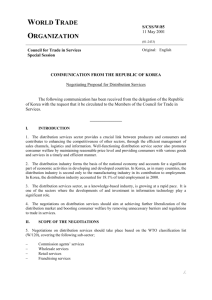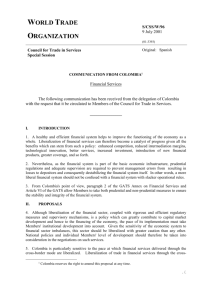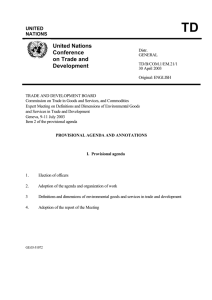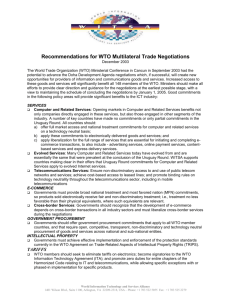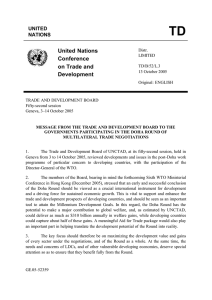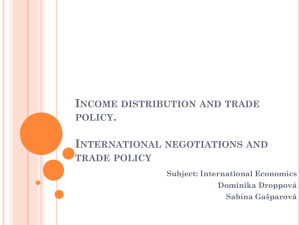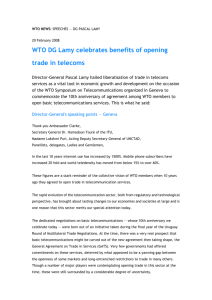TD United Nations Conference
advertisement
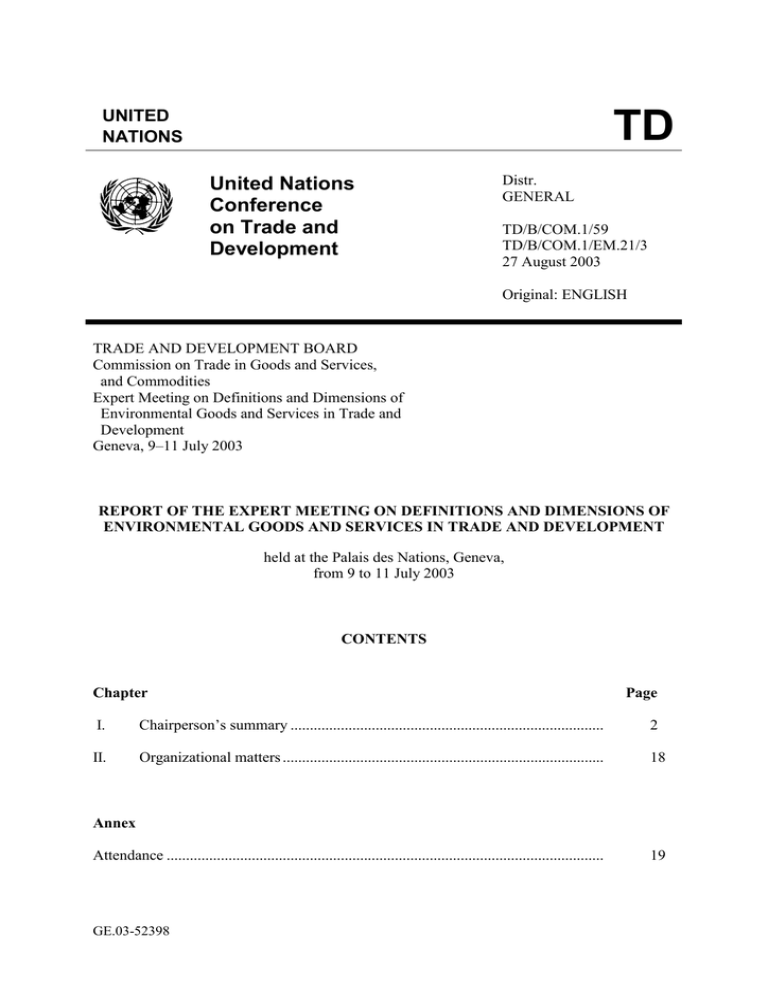
UNITED NATIONS TD United Nations Conference on Trade and Development Distr. GENERAL TD/B/COM.1/59 TD/B/COM.1/EM.21/3 27 August 2003 Original: ENGLISH TRADE AND DEVELOPMENT BOARD Commission on Trade in Goods and Services, and Commodities Expert Meeting on Definitions and Dimensions of Environmental Goods and Services in Trade and Development Geneva, 9–11 July 2003 REPORT OF THE EXPERT MEETING ON DEFINITIONS AND DIMENSIONS OF ENVIRONMENTAL GOODS AND SERVICES IN TRADE AND DEVELOPMENT held at the Palais des Nations, Geneva, from 9 to 11 July 2003 CONTENTS Chapter Page I. Chairperson’s summary ................................................................................. 2 II. Organizational matters ................................................................................... 18 Attendance ................................................................................................................. 19 Annex GE.03-52398 TD/B/COM.1/59 TD/B/COM.1/EM.21/3 page 2 Chapter I CHAIRPERSON’S SUMMARY 1. The Expert Meeting was attended by a large number of government experts (from both trade and environment ministries) from developed and developing countries and countries with economies in transition, representatives of private companies supplying environmental services, academics, and representatives of intergovernmental organizations and non-governmental organizations (NGOs). Participants expressed their appreciation of the fact that the Meeting had been scheduled back to back with the regular and special sessions of the WTO Committee on Trade and Environment (CTE). 2. Experts addressed issues relating to trade liberalization in environmental goods and services (EGS) from two perspectives. First, they considered definitions, classifications and negotiating approaches in the context of the WTO mandate provided for in paragraph 31 (iii) of the Doha Ministerial Declaration. Second, they discussed the role of EGS in sustainable development, in particular policies and measures that could be carried out at the national and international levels to strengthen the various EGS sectors in developing countries and to contribute to achievement of the Millennium Goals and the implementation of the Johannesburg Plan of Action adopted at the World Summit on Sustainable Development (WSSD). 3. A large part of the discussions focused on potential benefits from the liberalization of trade in EGS. Most experts referred to the need to secure “win-win-win” outcomes for trade, environment and development. As net importers of EGS, developing countries were more likely to benefit from increased availability of cheaper EGS than from increased exports. Developed countries expected benefits in terms of improved access to emerging environmental markets in developing countries and countries with economies in transition. Several experts said that while environmental benefits were of key importance to developing countries, a situation in which environmental benefits went to one set of countries and trade gains to another would not be a balanced outcome of the negotiations. The negotiations should therefore take fully into account EGS of export interest to developing countries. POTENTIAL BENEFITS FOR DEVELOPING COUNTRIES 4. Experts enumerated a number of potential benefits of EGS liberalization for developing countries, including the following in particular: access to environmentally sound technology (EST) and know-how; possible reduction in the relative prices of EGS; economic, environmental and developmental gains resulting from upgraded environmental infrastructure, more efficient resource management and improved environmental conditions; and enhanced capacity to comply with environmental requirements in domestic and international markets. 5. However, many experts expressed the view that caution and a gradual approach to liberalization commitments were needed in view of insufficient regulatory frameworks and institutional capacities, difficulties in assessing demand and supply, and insufficient understanding of the implications of liberalization, in particular in sub-sectors for which data TD/B/COM.1/59 TD/B/COM.1/EM.21/3 page 3 were largely unavailable. Several experts indicated that there was a need to study the experiences of developing countries that had already liberalized certain environmental services sub-sectors. Several developing countries had liberalized certain sub-sectors and allowed foreign direct investment, although no commitment had been made in the context of the General Agreement on Trade in Services (GATS). A number of experts said that no commitments could be made for services that were provided under government authority. Others stated that a balanced outcome of the negotiations would require commitments to be made on Mode 4 concerning sectors of interest to developing countries. 6. Many experts underscored that in order to "level the playing field" for developing countries it would be important to link the negotiations and discussions on EGS with a range of issues − for example, treatment of horizontal issues in services, namely emergency safeguard mechanisms, government procurement and classification; the role of subsidies for both environmental goods and services, particularly in developed countries; existing market structures of EGS and related anti-competitive practices; the key role of access to, and transfer and effective and efficient use of, ESTs; linkages to other negotiating areas of WTO, notably agriculture and market access; the relationship with objectives and instruments in relevant multilateral environmental agreements (MEAs); standards as a market entry barrier for EGS; supply capacity; and capacity building and policy coherence, at both national and international levels. ENVIRONMENTAL INDUSTRY: TRENDS, MARKETS AND TRADE FLOWS 7. The total size of the global environmental market is estimated at $550 billion in 2003. The United States, Japan and Western Europe accounted for 85 per cent of revenue generation in 2001. Annual growth in developed countries was 1.6 per cent in 2000 and 2001, and in developing countries 7−8 per cent. Environmental infrastructure services (water, wastewater, solid waste) constitute 62 per cent of the global market. 8. Markets in developed countries are "mature": they are highly competitive, with a highly sophisticated customer base, and experience slow or negative growth in many segments. Conversely, markets in developing countries represent many environmental needs. Translating these needs into consistent market demand required for investment by the private sector in business development hinges on a number of factors: regulations and enforcement; capital and companies; and ownership and/or contract mechanisms to ensure collection of fees, especially for water and waste infrastructure projects and the like. Capital requirements, in particular in water and wastewater management, are driving privatization and liberalization. In spite of environmental regulatory drivers, environmental markets are very sensitive to economic cycles. 9. Market determinants also differ. In developed countries, demand for services related to pollution control, compliance and clean-up or remediation is declining, and has been replaced by demand for services such as environmental consulting, eco-design of products, risk assessments and similar services. In many developing countries, on the other hand, market development is still determined by the need for basic environmental infrastructure services, and pollution control and clean-up services. TD/B/COM.1/59 TD/B/COM.1/EM.21/3 page 4 10. The largest environmental companies are concentrated in developed countries. However, participation by companies from developing countries in the water and wastewater and consulting sub-sectors is increasing. These are often companies from Asian and Latin American countries, which have acquired technological and services capacities, in part through joint venture investment in the environmental sector in their own country. A recent publication by UNCTAD, Energy and Environmental Services: Negotiating Objectives and Development Priorities, sets out important evidence of how capacity to provide and export environmental services has been developed in a number of developing countries. 11. A great number of environmental solutions are "low-tech" and require engineering and management skills as well as capital rather than proprietary technology. Clean, or "green", technology, as opposed to end-of-pipe, "brown" environmental technology, is difficult to pursue as a discrete business, and is difficult for researchers and policy makers to assess. 12. Ozone depletion, climate change and the management of hazardous substances, chemicals and waste, to name but the most important, are issues that require and have already led to some globalization of environmental policy. Market instruments offer potential for augmenting regulations in some segments, and create an incentive for "better than compliance" through partial internalization of environmental costs. ENVIRONMENTAL SERVICES 13. Environmental services differ greatly in market structure and behaviour, regulatory frameworks and technological development. Therefore, it is useful to distinguish between (a) environmental infrastructure services, mainly related to water and waste management; (b) non-infrastructure, commercial environmental services, comprising most of the activities in Central Product Classification (CPC) Division 94, for example site clean-up and remediation, cleaning of exhaust gases, noise abatement, and nature and landscape protection; and (c) related services with environmental end-use, classified under different divisions in the CPC, for example construction or engineering services. 14. Environmental infrastructure services have some of the characteristics of a “public good”. Key concerns in these services are universal access and prices. These services are highly subsidized in many developing countries as well as in some developed countries, and are provided largely by the public sector. However, there are experiences of provision of these services through private suppliers or through different modalities of public−private arrangements. 15. Environmental commercial services are knowledge-intensive and provided on an integrated basis. They are generally not subject to market access and national treatment limitations. The key issues with regard to these services are access to technology and knowhow, capacity building, certification and recognition of qualifications (for both natural persons and companies), and "tied aid" as a restriction on trade. 16. There is a range of services related to the environment. These are "multiple-use" services for which the questions of definition and coverage are as relevant as they are for most environmental goods. TD/B/COM.1/59 TD/B/COM.1/EM.21/3 page 5 17. A number of industrial or services sectors in developing countries could benefit from the provision of efficient environmental services. On the other hand, environmental support services are essential for commercially meaningful liberalization of environmental infrastructure services. Developing countries might increasingly find export opportunities in some environmental support services, for example environmental assessments, consultancy services, implementation and auditing of environmental management systems, evaluation and mitigation of environmental impact, and advice in the design and implementation of clean technologies. Partnerships with companies from developed countries can expand the scope for business opportunities for developing countries’ services suppliers, while at the same time allowing transfer of technology and capacity building. 18. Countries’ level of environmental protection and the use of environmental services are determined by a number of factors, for example environmental regulatory frameworks, including enforcement, the evolution towards pollution prevention approaches and the implementation of MEAs. 19. The main way to trade environmental services is through commercial presence and the temporary movement of natural persons, given the need for highly specialized professionals in many of these services. The importance of Mode 4, especially for environmental support services, is growing. Individual service providers from developing countries are sometimes subject to discriminatory treatment. In this context, it was asked whether there is a compilation of existing qualification and certification requirements. 20. Environmental services are playing an important role in ongoing negotiations under GATS Article XIX. Most developing countries have received requests to undertake specific commitments in all environmental services, largely from developed countries. Some WTO Members have incorporated new commitments or improvements in existing commitments: out of 26 initial offers, nine have incorporated environmental services. The task of the negotiations is to set the right framework, which would require agreeing on classification and identifying and reducing the main barriers to trade. 21. At their current stage, the negotiations on environmental services raise the following issues: convergence on the classification of environmental services for negotiations purposes; a common understanding of what is meant, in a commercial sense, by some proposed new categories of services such as biodiversity protection; remediation and clean-up of soil and water; the need for a clear picture of the extent and scope of subsidization of environmental services; problems associated with the recognition and certification of professional services; "tied aid", that is situations in which a service provider is pre-selected as part of a development assistance package; qualification and certification requirements for individual service providers; and transfer of technology. 22. National classifications of environmental services have not been drawn up for trade negotiations and differ greatly. The two main instruments used in the WTO are the Provisional Central Product Classification and the Services Sectoral Classification List (W120). However, no classification is obligatory and WTO Members are free to use any classification they prefer or to develop a classification of their own. Both national and international classifications are rather removed from market realities. Some participants expressed concern that different classifications are used in the bilateral requests and offers TD/B/COM.1/59 TD/B/COM.1/EM.21/3 page 6 process instead of classification issues being addressed multilaterally in the competent body, the Committee on Specific Commitments. 23. Proposals have been made to update the classification of environmental services to better reflect market realities. In addition, attempts have been made to take account of environmental “end-use” services or services with an “environmental component” in order to secure commercially meaningful commitments. 24. The most far-reaching proposal for updating the W/120 comes from the European Union (EU). It is based on, though not identical with, the OECD/Eurostat definition of environmental services, which goes beyond the classification proposed by the EU for the purpose of trade negotiations. In particular, it addresses the entire water cycle and the protection and preservation of landscape, eco-systems and biodiversity. 25. The proposal by the EU is indicative of the strong trade interest of EU companies in all environmental services. The EU has made requests for liberalization of environmental services to 64 WTO Members, but on a differentiated basis, taking into account their level of development. Conversely, the EU did not include liberalization of water distribution services in its initial offer, mainly because there was only one request. 26. While Governments may resort to their preferred classification, the use of new definitions, overlaying the CPC classification, may have implications, for example when included in the schedule. It has been pointed out that any new classification may give rise to adaptation problems with respect to existing commitments from the Uruguay Round. The translation of commitments from one classification to another might imply a modification of such commitments. 27. Arguably, the specific commitments of market access (GATS Article XVI) and national treatment (GATS Article XVII) have the greatest potential impact on national regulatory regimes. Since commitments are made on a sectoral basis, classification of services is of vital importance in this context. Classification is therefore also of relevance in the current GATS 2000 negotiations about future commitments. 28. It is important to realize that trade in environmental services can take place, and does take place, in the absence of commitments under the GATS. While there are barriers to international trade in services, the main problem is not so much restrictions on trade as the lack of demand. The main issue therefore is how to strengthen demand for environmental services and promote appropriate implementation of environmental policy, including through the establishment and enforcement of environmental standards and regulation. 29. According to some experts, environmental infrastructure services, such as water and wastewater management, are essentially a development issue rather than a trade issue. Therefore, the liberalization of trade in these services should be seen in a broader context of sustainable development. 30. The more traditional environmental infrastructure services, such as water and waste management, are provided mostly by the public sector. Moreover, these services often are, or are close to being, natural monopolies, or are provided through monopolies for public policy TD/B/COM.1/59 TD/B/COM.1/EM.21/3 page 7 reasons. Even when the provision of these services is handed over to, or shared with, the private sector, this often happens under monopolistic structures. Therefore, competition takes place for markets, rather than in markets. 31. The private sector provides water distribution services to about 5 per cent of the world's population. The private provision of water service is a politically and socially sensitive issue. The main concerns have to do with price increases, unsustainable use of water resources, loss of public ownership and rent-seeking practices. Few countries have their water services fully privatized. Public−private partnerships (PPPs), especially concessions, are preferred to full privatization. 32. Companies operating in the environmental industry use various contractual arrangements to form PPPs, which are adapted to local and national conditions, in order to meet the expectations of municipalities and Governments, and to comply with national regulations. The perceived gains of PPPs for developing countries are of a financial (capital inflow), technical (optimized operations; technical assistance from other countries; training of personnel) and managerial nature (more efficient organizational structure; billing and fee collection; financial savings on purchases). 33. Issues relating to charges for water and subsidies have to be seen in a pragmatic perspective. Pricing is not exclusively a private sector problem. In a subsidized environment, the private sector may sometimes operate in a manner similar to that of a public company operating in a non-subsidized environment. 34. Large private operators currently have a very small market share in developing countries. Small-scale independent water providers, operating small pipe networks, distribution at kiosks and water trucks, currently play a major role in developing countries, where in many cities half of the population or more is served by water suppliers other than the utility. Until now the trade liberalization and water services debate has focused on largescale operators and ignored small-scale operators. It is important to broaden the debate to address issues specific to decentralized water systems, particularly the ways and means of promoting partnerships involving local engineering companies and engineering companies from developed countries. 35. Given the sheer magnitude of intergovernmental commitment on water and sanitation, the public sector should be central to the development and use of water resources, and remains a necessary option in water management. Public sector water undertakings (PWUs) are the providers of water and sanitation services for the great majority of the population in developed and developing countries. Ignoring a public sector option means that the main competitor of any of the private companies is being excluded. 36. There is evidence of problems with PPPs, and at the same time there is evidence that the public sector can successfully operate PWUs in developing countries. Therefore, policy makers should always construct and consider a public sector option, and always evaluate any PPP proposal against a public sector option in a public process. 37. The GATS neither requires nor precludes a particular regulatory regime. WTO Members are free to design a regime of infrastructure services regulations according to their national priorities and development strategies. They must, however, observe certain GATS TD/B/COM.1/59 TD/B/COM.1/EM.21/3 page 8 disciplines when adopting and implementing particular regulatory instruments. They must also be aware that the GATS creates a certain momentum towards liberalization of services regulation. Hence, WTO Members choosing a regulatory regime that relies on government intervention in the market and restrictions on economic activities may have to be more aware of possible GATS constraints on national regulation than Members opting for solutions relying on competition and market forces. 38. WTO Members that want to rely on domestic services and service suppliers in a particular sector or to retain a maximum degree of regulatory flexibility may consider remaining unbound in that sector − that is, not making any commitments. Members that want to commit certain sectors should carefully assess their regulatory regime and the implications of market access and national treatment for it, and should also consider their need for future regulatory flexibility when scheduling limitations to their commitments. 39. Water regulation often pursues goals that are specific to the water sector, such as managing scarce resources, guaranteeing drinking water quality, and aiming at or securing universal access to water. It can also aim at other goals such as efficiency of distribution, transfer of technology or rural and agricultural development. Some of these goals may require instruments that could be incompatible with market access and national treatment, and may therefore require scheduling limited commitments, refraining from commitments altogether, or carefully scheduling the limitations a country wishes to maintain. 40. WTO Members should also assess the ongoing negotiations on disciplines for domestic regulation in the Working Party on Domestic Regulation in the light of their regulatory requirements. Pursuant to GATS Article VI:4, such disciplines should ensure that certain domestic regulations (measures relating to licensing and qualification requirements and procedures, and technical standards) are no more burdensome than is necessary to achieve national policy objectives. Depending on the scope of future disciplines and the specific design of a "necessity test" in such disciplines, certain domestic regulations such as quality standards or universal service obligations could be seen as more burdensome than necessary. This may put them under pressure from the multilateral trading system. 41. It is very rare that water services are fully privatized. Usually, they are provided directly by central or local government authorities, or through various public–private arrangements. In this context, there is a need to clarify the meaning of services provided under governmental authority and of market access. With respect to services provided under governmental authority, there are differing interpretations of the scope of the exclusion from the GATS. According to some, for the exclusion to apply, the service must be supplied neither on a commercial basis nor in competition; if one of those conditions is not met, the exclusion does not apply. For others, however, it is sufficient that one of the conditions is met for the exclusion to apply. With respect to market access, it was asked whether the right to participate in the bidding process amounts to granting market access, and whether some concessions may fall within the realm of government procurement and therefore be excluded from GATS provisions. 42. According to some participants, some of the various forms of relationship between government authority and a private supplier would correspond to government procurement and are therefore exempted from the relevant GATS disciplines. However, the distinction TD/B/COM.1/59 TD/B/COM.1/EM.21/3 page 9 between these various forms is not always clear, and this prompts questions about what types of water contract could or could not be considered government procurement. 43. The GATS is a flexible instrument, but only if it is used in a flexible way. Options available to developing countries in managing the impact of liberalization of public services under the GATS include the following: horizontal exclusion of public services (e.g. Dominican Republic); sector-specific exclusion of public services (e.g. Norway and Switzerland); commitments limited to private sector suppliers (e.g. sewage services in the United States); sub-sectoral "carve-outs" (e.g. for infrastructure); and specific limitations to exclude certain regulatory measures (e.g. subsidies). 44. Countries have the possibility of tailoring their commitments through the bottom-up approach, so as to define their way to market access. However, there is a great deal of pressure on national and local regulatory authorities, which often lack the necessary resources and capacity. Regulations are crucial to ensuring the "quality" of the liberalization process. There is a need to sequence regulatory consolidation and liberalization. Detailed knowledge of regulations are also crucial to negotiations. In a sense, it would be fair to say that trade negotiators should know what regulators know, and vice versa. ENVIRONMENTAL GOODS 45. The Doha mandate explicitly calls for the liberalization of trade in environmental goods. From a policy perspective, relevant questions are (a) whether to grant special treatment to such goods and, if so, in what form; and (b) to which goods special treatment would be granted. The relative importance of tariffs and non-tariff barriers and supply capacity should also be considered. The Doha mandate appears to impose two sets of conditions. First, paragraph 31 suggests that in order to benefit from special treatment, environmental goods should be identified "with a view to enhancing the mutual supportiveness of trade and environment". This in turn raises the question of how to deal with “multiple-use” products. Second, negotiations on environmental goods should take into account the overall objectives of market access negotiations. They should therefore also be guided by paragraph 16 of the Doha Ministerial Declaration and pay particular attention to “products of export interest to developing countries”; take full account of the special needs and concerns of developing countries; require “less than full reciprocity in reduction commitment” from developing countries; and promote capacity building. 46. Current approaches do not adequately reflect developing countries’ interests. Several experts made proposals aimed at achieving a more balanced outcome of the negotiations, in particular by identifying products of export interest to developing countries; excluding “multiple-use” products that may have little environmental application; and addressing technology and capacity-building needs. 47. As there is no agreed definition of environmental goods in the WTO, experts focused their discussions on various "lists" of environmental goods rather than on issues of definition. 48. The Organisation for Economic Co-operation and Development (OECD) and AsiaPacific Economic Cooperation (APEC) have developed lists of “environmental goods”. While the OECD list was developed for analytical purposes, the APEC list was compiled on TD/B/COM.1/59 TD/B/COM.1/EM.21/3 page 10 the basis of proposals by individual APEC members as a bottom-up approach to the Early Voluntary Sectoral Liberalization (EVSL) initiative, which includes the environmental sector. The OECD list does not go beyond the 6-digit Harmonized System (HS) classification, whereas the APEC list includes many “ex-headings” (nationally defined tariff lines). The APEC list might therefore be more precise in identifying environmental goods, although the problem of “multiple-use” products remains. In the EVSL context, some goods (e.g. waste incinerators) had been excluded from the APEC lists at the request of civil society. One expert said that large hydraulic turbines should not be put on lists of environmental goods, because of adverse environmental implications. It has been pointed out that many pollution abatement products on the OECD and APEC lists are “end-of-pipe” technologies. 49. Some experts proposed that the APEC list could be used as a starting point, but by no means the end point, in identifying environmental goods for the purposes of trade negotiations. Others thought that the APEC list was not a good starting point and that any list could be used. It has been emphasized that, in principle, no products were a priori excluded from the scope of environmental goods and no proposals have been made to that effect. Most WTO Members, however, have objected, on practical and systemic grounds, to the use of criteria based on non-product-related processes and production methods to define environmental goods for the purposes of the negotiations. 50. Products proposed for listing as environmental goods because of performance criteria, such as energy efficiency at consumption, are another problematic category. The main reason is that these products are subject to innovation and technological change, and products that are environmentally superior today may not be so tomorrow. 51. Criteria should be practical and simple, and adequate account should be taken of constraints on the capacity of customs authorities to administer products subject to special treatment. Any lists of environmental goods should be kept current, so as to regularly include new products and exclude products that no longer qualify as environmental goods. 52. It may become necessary to make proposals for tariff reductions at the national tariff line level (beyond the 6-digit level of the HS classification), as was done in the Agreement on Information Technology. Some experts indicated that the World Customs Organization could be asked to introduce new tariff lines to capture environmental goods. There may be a need to look into the question of how to deal with agricultural products in the context of the negotiations. 53. A United States expert familiarized the participants with a proposal submitted recently by the United States to the Negotiation Group on Market Access for NonAgricultural Products (NGMA), which contains elements concerning both product coverage and modalities for negotiations. According to the US proposal, two lists of environmental goods could be developed. A core list would comprise products on which there was consensus that they constituted environmental goods. A complementary list could be developed for additional products that could have significance for environmental protection, pollution prevention or remediation, and sustainability. Tariffs should be eliminated for all products on the core list as soon as possible but no later than 2010. With regard to the complementary list, Members would be required to eliminate tariffs for a certain (“x”) TD/B/COM.1/59 TD/B/COM.1/EM.21/3 page 11 percentage of these tariff lines by 2010. For developing countries, this percentage could be lower in order to reflect less than full reciprocity provisions. 54. The UNCTAD secretariat circulated a Conference Room Paper (TD/B/COM.1/EM.21/CRP.1) examining recent patterns of international trade in products on the OECD and APEC lists as well as certain products that, for illustrative purposes, could be considered environmentally preferable products (EPPs) on the basis of product characteristics. However, the secretariat emphasized that trade statistics at the 6-digit level of the HS tend to significantly overestimate trade flows, as many “environmental goods” are “ex” items. The fact that many products listed as “environmental goods” are in fact “multiple- use” products aggravates this problem. Some conclusions can nevertheless be drawn (based on trade statistics for the year 2000): • • • • All developing countries for which trade data are available are net importers of environmental goods on the APEC list. Only two developing countries (Guinea and Trinidad and Tobago) are net exporters of products on the OECD list as a result of exports of one or two chemical products (the chemical sector is excluded from the APEC list). "Multiple-use" products represent a large share of developing countries’ trade in products on both lists, as is illustrated by the fact that the major export and import items of developing countries are “basket” items. Trade data for all regions show that the products on either the APEC or the OECD list represent not more than 3 per cent of exports and not more than 6 per cent of imports of manufactured goods (i.e. products covered by the negotiations in the NGMA). South−South trade may be relatively more important, in particular trade between developing countries in Asia. Developing countries as a group are net exporters of 26 of the 182 environmental goods on the APEC and OECD lists. 55. There is a need to identify a larger range of products of export interest to developing countries in order to work towards a more balanced outcome of the negotiations. At the same time, several experts said that a range of “multiple-use” products with predominantly industrial, as opposed to environmental, end-use should be excluded from any lists of environmental goods. The issue of “multiple-use products” is more important to developing countries that maintain relatively higher tariffs, as this could involve the loss of significant tariff revenues without necessarily generating environmental benefits. 56. Several experts emphasized that liberalization in renewable energy products could result in clear environmental benefits as well as increased exports for certain developing countries. Renewable energy products are included in the OECD and APEC lists, but their coverage could be broadened by including additional products, and developing countries’ exports in related services could be promoted (see also next section). 57. Experts from several developing countries proposed that certain categories of EPPs be included within the scope of the negotiations on environmental goods, while avoiding possible new non-tariff barriers and additional costs (e.g. for certification). TD/B/COM.1/59 TD/B/COM.1/EM.21/3 page 12 58. In particular, proposals were made for the inclusion of non-timber forest products, products based on traditional knowledge (TK) and products made from natural fibres such as jute and coir. One expert proposed a list of environmental goods consisting of recycled waste, water products, air-pollution-abatement products, soil-conservation products and products derived from ecosystems. 59. Examples were given of tariff and non-tariff measures affecting trade in EPPs. Trade in TK-based products is affected by registration requirements, health requirements and “novel food” legislation. In the case of jute and coir, tariffs in developed countries are low for raw materials, but relatively high for manufactured and semi-manufactured goods in some markets. Concern has been expressed that certain packaging requirements could discriminate against jute as a packaging material. In the area of renewable energy products, a case study on solar energy equipment shows that some developing countries have acquired international competitiveness, but tied aid can be an obstacle to their exports. 60. Several experts argued for expanding the scope of negotiations beyond the lists of goods to include technology and financing and thereby promote an integrated approach to environmental problems. 61. Most experts were of the view that certain categories of EPPs would be problematic in the context of the WTO negotiations concerning paragraph 31(iii). Examples cited include organic agricultural products and products requiring an eco-label or another form of certification to be identified as EPPs. However, this should not detract from the importance of removing obstacles to, and promoting, developing countries’ exports of those products. For example, in the area of organic agriculture, there is a need to address problems such as standards, certification and subsidies in some developed countries. In this context, references were made to the WSSD call for actions to “[S]upport voluntary WTO compatible marketbased initiatives for the creation and expansion of domestic and international markets for environmentally friendly goods and services, including organic products, which maximize environmental and developmental benefits through, inter alia, capacity-building and technical assistance to developing countries”. 62. References were made to the work on EPPs that UNCTAD has been carrying out for several years, although not in the context of the WTO negotiations on environmental goods. It would be useful to review this work. This could be helpful in identifying products and measures that could be covered in negotiations under paragraph 31(iii) and issues that could be addressed more effectively in other WTO bodies dealing with non-tariff barriers or through trade promotion measures. 63. UNCTAD, in cooperation with other institutions, could be of assistance, drawing on its work on commodities, BIOTRADE and the International Task Force on Harmonization and Equivalence in Organic Agriculture, created jointly with the Food and Agriculture Organization of the United Nations (FAO) and the International Federation of Organic Agriculture Movements (IFOAM). TD/B/COM.1/59 TD/B/COM.1/EM.21/3 page 13 EGS AND TECHNOLOGY 64. One of the key interests of developing countries in liberalization of EGS is enhanced access to and effective use of ESTs. It is, however, important to take a holistic view of the transfer of ESTs, linking it to investment and access to other sources of funding, licensing of intellectual property rights (IPRs), availability of skilled staff and other services, such as engineering and construction, as well as support through development cooperation and MEAs. Small and medium-sized enterprises, both in developing and in developed countries, play a key role in technological development, including cleaner technologies. All these factors underline the importance of policy coherence, at both national and international levels. 65. Experts identified three areas for which transfer and effective use of ESTs would be of particular importance in the next few years: (a) enhancing energy and material efficiency (this includes saving devices and technologies and the use of renewable energy and materials, including biodegradable material); (b) responding to stringent environmental requirements in export markets (in particular as regards the management of hazardous metals and chemicals and related traceability requirements); and (c) addressing escalating urban pollution, such as air- and water-borne pollution. 66. Anticipating the entry into force of the Kyoto Protocol in 2003, some sectors in the environmental industry have increasingly identified significant potential for climate change technologies – that is, technologies that help reduce greenhouse gas emissions. It is expected that the potential expansion path for climate change technologies will initially occur in developed economies. However, the Kyoto Protocol foresees mechanisms by which developing countries should be assisted, primarily through technology transfer and diffusion as well as through the Clean Development Mechanism. 67. Trade liberalization has to cover a broader range of renewable energy goods than current lists indicate, and this should also include devices, products, systems and services related to the production, use and maintenance of renewable energy equipment 68. Experts had divergent views on how to address cleaner production technologies in the context of the EGS negotiations. Some referred to the difficulties in defining cleaner technologies and classifying them in the HS. "Clean" is a concept of "relative" environmental performance, subject to change in the course of time. Also, many cleaner production technologies are sector-specific. 69. In many cases there appears to be the possibility of classifying entire technology systems under a single tariff heading. However, more work is needed in order to find the appropriate tariff headings or to create new ones. In this regard, a proposal was made for a WTO expert committee/group to review classification issues, product coverage and non-tariff barriers. 70. According to some experts, the difference between end-of-pipe and clean technologies should not be exaggerated. For instance, filters, often mentioned as a prime example of end-of-pipe technologies, are also used in clean processes. The problem of "relative" environmental performance could be overcome by (a) setting up a proper review TD/B/COM.1/59 TD/B/COM.1/EM.21/3 page 14 mechanism for the list of environmental goods, and (b) including entire plants or technologies in the list. Plants and systems are devoid of multiple-use and “relativism in time” problems. They are specifically designed and made for environmental purposes − for example, a recycling plant remains a recycling plant even if the technology of recycling changes substantially. Examples of entire plants that could be covered are numerous: recycling plants, plants for waste management, sulphuric acid recovery plants, and plants for cogeneration of heat and power. The same approach could apply to entire technology systems, for example oil recovery systems. 71. A technology-based approach to the liberalization of trade in EGS could be considered. Such an approach would encompass (a) traditional environmental technologies, (b) integrated environmental technologies, (c) energy-saving devices and technologies, and (d) technologies based on renewable energy sources. 72. Many environmental problems, particularly in developing countries, do not require state-of-the-art and proprietary technology; rather, they could be addressed through developing management skills, combined with appropriate technology. Second- and thirdbest solutions are often not only an efficient but also an effective way of overcoming environmental and resource management problems. In this regard, endogenous technology solutions are sometimes seen as providing a better match with local environmental problems and therefore merit more attention. SYSTEMIC ISSUES 73. The GATS is an agreement that is still very much in the making. There are open questions, particularly in the area of rules. For example, a case has to be made, from a technical point of view, for emergency safeguards. For the moment the WTO Members are negotiating under the mandate of Article X, but the issues of desirability and feasibility have not yet been resolved. 74. As regards subsidies, not only have the WTO Members not been able to develop disciplines, but also there is no transparency. The exchange of information called for in Article XV has not produced the expected results. Only four Members have responded to the questionnaire that was distributed. Several experts said that Members negotiate without knowing what subsidies exist and are naturally concerned about opening their markets because they will be absorbing distortions originating in domestic or export subsidies provided by other Members. Discussions on government procurement are still ongoing, and some work has been done on domestic regulations, but more progress is required. Furthermore, the importance of work on classification issues has been highlighted by the different proposals submitted during the current negotiations. 75. A number of regional integration agreements are being drafted, with a high level of ambition and incorporating a negative-list approach to the liberalization of trade in services. Various models are being constructed, sometimes incorporating agreements on mutual recognition, for example in professional services, and chapters on investment, which are also based on a negative list. TD/B/COM.1/59 TD/B/COM.1/EM.21/3 page 15 76. It is important to realize, however, that these regional agreements are essentially "stand-still" exercises. In other words, Governments do not make changes to their domestic regulations because of the negotiations, with the exception of countries that have to change their regulatory regimes because of the negotiations on accession to the WTO, as a "price of entry". 77. Environment is a horizontal issue par excellence. Public services and private activities cut through the various areas of environmental activities, which are partly public and partly private. And like any other area where there is public interest to tackle, the environmental area cuts across almost every field of WTO law, thus raising questions about the structure of the negotiations. 78. One international expert suggested that an alternative way to approach the negotiations is to reduce the matter in its vast complexity and redefine the subject of the negotiations in terms of problem areas. Such an approach would obviate the need to define EGS in a more theoretical manner. For example, if sanitation were to become such an area, the negotiations would have to consider goods and services relevant to this area. Other possible areas are air pollution and the loss of biodiversity, or any other area where developing countries may have a strong interest. A "negotiating package" might include two or three such areas. 79. Once a particular sector or sectors are chosen, a number of issues would have to be dealt with. First, reduction or elimination of tariffs on relevant goods would have to be considered, as was the case during the Uruguay Round with pharmaceutical, medical and chemical equipment. If (some) Members were found to operate apply excessive standards, there would have to be negotiations on standards. With respect to IPRs, Articles 66:2 and 67 of the Agreement on Trade-Related Aspects of Intellectual Property Rights (TRIPS) could be implemented, with developed WTO Members providing incentives for transfer of technology. Promoting transfer of technology, in practical terms, might raise the question of whether there should be a subsidy programme, which would then lead to negotiations under the Agreement on Subsidies and Countervailing Measures. For instance, countries may support, specifically for the sector chosen, the reintroduction of non-actionable subsidies, which is currently being discussed, including exemption for environmental services. Balancing public services with private input would require looking into issues relating to government procurement and trade-related investment measures (TRIMs). Such an approach may eventually lead to an agreement specific to this sector, or it may stay at the level of coordination between different negotiating bodies and agendas. The CTE special session would have a unique role to play in terms of communicating these various agendas to other negotiating bodies. 80. Liberalization efforts in the WTO should be considered in connection with possibilities of financing such efforts. Besides, there are constraints on the supply side, to which the WTO is ill equipped to respond. No institutional linkages have been established between the negotiations and all the different forums that deal with development finance and assistance. Rather than working along the lines of the past, there is a need to find new modalities, and to channel the problems institutionally to ensure that liberalization efforts in the WTO are commercially, financially and technically viable. TD/B/COM.1/59 TD/B/COM.1/EM.21/3 page 16 81. Several experts highlighted the importance of MEAs for fostering EGS markets. MEAs can harmonize EGS markets and related policies. They can contribute to better policy coherence, at both national and international levels, and through packages of supportive measures can facilitate access to, and transfer and effective use of, ESTs. The Montreal Protocol was referred to as one of the most successful accords in this regard. 82. Any progress on EGS will depend on progress on other negotiating agendas. Meetings such as this Expert Meeting may help bring to the surface the needs of various countries, better define public policies and negotiating objectives, and help the negotiations along. STRENGTHENING CAPACITIES IN DEVELOPING COUNTRIES 83. Many experts emphasized the need for capacity building and expressed appreciation for UNCTAD’s efforts to assist developing countries in issues related to EGS, including through the promotion of policy dialogues (involving trade negotiators, policy makers in environment, trade and other ministries, regulatory authorities and other stakeholders) and studies. Several experts presented their national experiences on the basis of activities carried out under the project “Building Capacity for Improved Policy Making and Negotiations on Key Trade and Environment Issues”, including country studies, a regional meeting held in Cuba (March 2003) and national workshops in Nicaragua (June 2003) and Panama (June 2003). Similarly, the results of a seminar on liberalization in EGS held in India (May 2003) under the project “Strategies and Preparedness for Trade and Globalization in India” (including a range of papers) were made available to the Expert Meeting. Both projects are funded by the United Kingdom’s Department for International Development. 84. The UNCTAD secretariat has also addressed issues relating to EGS in a regional workshop (under the UNEP−UNCTAD Capacity Building Task Force on Trade, Environment and Development, CBTF) in Singapore (May 2002) and at WTO regional seminars in Latvia (September 2002) and Bolivia (February 2003). RECOMMENDATIONS 85. Discussions among experts led to a number of recommendations, set out below, to be pursued at appropriate levels. National level 86. Several recommendations made at the Meeting referred to possible actions at the national level: • • • Development of a list of environmental goods that reflects a country’s sustainable development and trade interests; Implementation of policies and measures that translate environmental, human health and resource management needs into demand for EGS; Coordination among all relevant policy contexts to ensure an integrated approach to the development of the various EGS sectors and trade liberalization; TD/B/COM.1/59 TD/B/COM.1/EM.21/3 page 17 • • Promotion of policy dialogues involving trade negotiators, policy makers, regulators, providers of environmental services and other stakeholders; Sequencing of regulatory consolidation and liberalization. International community 87. Several issues raised at the Expert Meeting would require action by the international community: • • • • • • • There needs to be more work on developing consensus on the classification of environmental services. Greater importance should be attached to developing practical approaches to compiling a list of environmental goods and related criteria for the purposes of negotiations. It is important to choose the right forums for advancing the various segments of the EGS agenda. Greater policy coherence is required between provisions on EGS in bilateral and regional trade agreements and the multilateral trading system, as well as with policies of international financial institutions and development assistance bodies on EGS. Greater coherence will also be required between the various areas of ongoing WTO negotiations and discussions, notably the areas of non-agricultural and agricultural products, services, technical barriers to trade, subsidies and countervailing measures, TRIPS, TRIMs and government procurement. There is a need to promote coherence with instruments of relevant MEAs. More in-depth discussion is required on the relationship between transfer of ESTs and trade liberalization of EGS. UNCTAD 88. There are a number of ways in which UNCTAD could assist developing countries and countries in transition in the area of EGS. It could: • • • • • Continue to provide assistance to developing countries in organizing national policy dialogues and undertaking analytical and empirical studies, including the development of methodologies, with a view to clarifying issues related to the liberalization of trade in environmental services; Assist, on request, developing countries in compiling lists of environmental goods that reflect their trade, environmental and developmental priorities; Submit a report to the CTE special session on key issues of interest to developing countries in the context of paragraph 31 (iii) of the Doha Ministerial Declaration: Contribute to the clarification of issues related to the transfer of ESTs and trade in EGS; Continue to assist interested developing countries in issues related to EGS and/or the promotion of exports of EPPs through appropriate capacity-building activities such as the CBTF, the project “Building Capacity for Improved Policy Making and Negotiations on Key Trade and Environment Issues” and the BIOTRADE Initiative. TD/B/COM.1/59 TD/B/COM.1/EM.21/3 page 18 Chapter II ORGANIZATIONAL MATTERS A. Convening of the Expert Meeting 89. The Expert Meeting on Definitions and Dimensions of Environmental Goods and Services in Trade and Development was held at the Palais des Nations, Geneva, from 9 to 11 July 2003. B. Election of officers (Agenda item 1) 90. At its opening meeting, the Expert Meeting elected the following officers to serve on its bureau: Chairperson: Vice-Chairperson-cum-Rapporteur : Mr. Dacio Castillo (Honduras) Mr. Richard Ballhorn (Canada) C. Adoption of the agenda and organization of work (Agenda item 2) 91. At the same meeting, the Expert Meeting adopted the provisional agenda circulated in document TD/B/COM.1/EM.21/1. The agenda for the Meeting was thus as follows: 1. 2. 3. 4. Election of officers Adoption of the agenda and organization of work Definitions and dimensions of environmental goods and services in trade and development Adoption of the report of the Meeting D. Documentation 92. For its consideration of the substantive agenda item, the Expert Meeting had before it a note by the UNCTAD secretariat entitled “Environmental goods and services in trade and development” (TD/B/COM.1/EM.21/2). E. Adoption of the report of the Meeting (Agenda item 4) 93. At its closing meeting, the Expert Meeting authorized the Rapporteur to prepare the final report of the Meeting under the authority of the Chairperson. TD/B/COM.1/59 TD/B/COM.1/EM.21/3 page 19 Annex ATTENDANCE ∗ 1. Experts from the following States members of UNCTAD attended the Meeting: Angola Bangladesh Barbados Benin Botswana Brazil Burkina Faso Canada Chile China Colombia Costa Rica Cuba Democratic Republic of the Congo Denmark Dominican Republic Ecuador Egypt Ethiopia Finland France Gabon Germany Guinea Honduras India Indonesia Iran (Islamic Republic of) Kenya Madagascar Malaysia Mauritania Monaco Nepal Netherlands Nicaragua Nigeria Paraguay Philippines Republic of Korea Russian Federation Saudi Arabia Senegal Serbia and Montenegro South Africa Spain Sweden Switzerland Syrian Arab Republic Thailand Trinidad and Tobago United States of America Venezuela 2. The following observer country was represented at the Meeting: The Holy See 3. The following intergovernmental organizations were represented at the Meeting: African, Caribbean and Pacific Group of States European Commission Organisation for Economic Co-operation and Development South Centre ∗ For the list of participants, see TD/B/COM.1/EM.21/INF.1. TD/B/COM.1/59 TD/B/COM.1/EM.21/3 page 20 4. The following specialized agencies and related organization were represented at the Meeting: International Labour Organization United Nations Industrial Development Organization World Trade Organization 5. The following non-governmental organizations were represented at the Meeting: General Category Center for International Environmental law International Centre for Trade and Sustainable Development 6. The following special invitees attended the Meeting: S.E. Mme Yolande Bike, Ambassadeur, Mission permanente du Gabon, Genève Mr. David Boyz, PSIRU, Geneva, Switzerland Ms. Chantal Line Carpentier, Head, Environment, Economy and Trade Program, Commission for Environmental Cooperation, Montreal, Canada Mr. Thomas Cottier, Director, World Trade Institute, Berne Mr. Charles-Luis De Maud-Huy, Veolia Environment, Paris, France Ms. Michele Ferenz, GFTED Project Director, Consensus Building Institute Inc. Cambridge, MA, United States Mr. David Hall, Director PSIRU, London Mr. Nicolae Heredea, Director, NHN Ecoinvest, Bucharest, Romania Mme Valerie Pleinemaison, Veolia Environment, Brussels, Belgium M. Pascal Roger, Groupe Suez, Paris, France Mr. Sunandan Roy Chowdhury, Research Director, Environmental Policy Unit, Consumer Research Action & Information Centre, Calcutta, India Mme Laurence Tubiana, Directrice, Institut de développement durable et des relations internationales, Paris, France M. Pierre Victoria, Veolia Environment, Brussels, Belgium 7. The following resource persons attended the Meeting: M. Dominique Drouet, Directeur, Recherche Développement International, Paris, France Mr. Grant Ferrier, President, Environmental Business International Inc., Editor, Environmental Business Journal, San Diego, California, United States of America Mr. Felipe Hees, Ministry of Foreign Affairs, Brasilia, Brazil M. Markus Krajewski, School of Law, King's College, London, United Kingdom Sr. Enrique Lendo, Mexico D.F., Mexico Mr. Swarnim Wagle, UNDP Asia Trade Initiative, Ho Chi Minh City, Viet Nam _______
